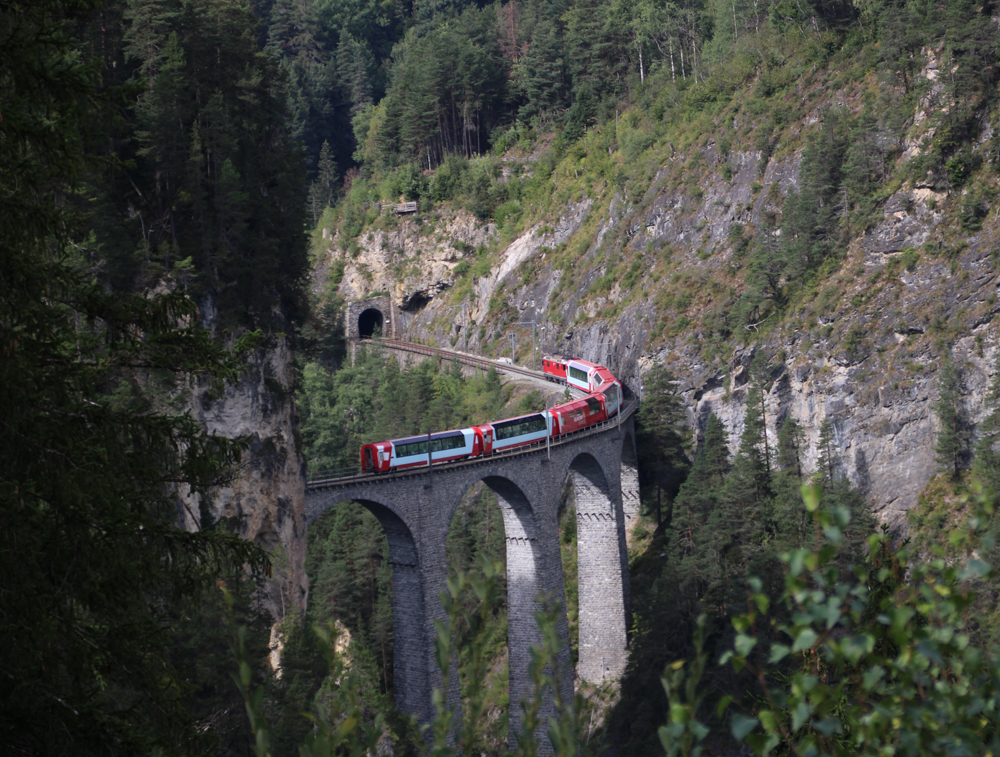
SCUOL-TARASP, Switzerland — It’s cold and wet tonight in the Alps — the rain I’ve been contending with for most of the day has turned to snow at the higher altitudes — so it’s a good evening to get up to date on the senior editor’s 2024 Swiss Saga:
Tuesday, Sept. 11: The second day of my four-day agenda arranged by the amazing meter-gauge Rhatische Bahn found me meeting with marketing manager Camille Härdi at the station in Landquart — an 8-minute train ride from Chur — for a ride to Davos, one of those place names most Americans probably associate with rich and powerful because it annually plays host to the World Economic Forum. (Attendees in 2024 included 60 heads of state and more than 300 other government minister.)
Since neither Camille or I have much ability to influence the value of the franc, dollar, pound, yen, euro, or dinar, we were en route to Davos for more a more modest reason, albeit one far more germaine to this blog. The RhB operates a daily “Nostalgia train” between Davos and Filisur — operating with a heritage electric locomotive and vintage passenger cars dating to the 1920s, along with a slightly newer open-air coach. En route, we talked about various RhB marketing activities and enthusiast-oriented offerings for railfans (these are extensive, as I’ll discuss at length at a future date). Normally, the train would be pulled by one of the railroad’s two vintage “crocodile” electrics — among the star’s of the RhB’s 72-piece heritage fleet, as discussed in the first installment of this report [see “Swiss Saga, 2024, part 1 …,” Trains.com, Sept. 11, 2024]. Sadly, both of these historic rail reptiles are sidelined for repairs, leaving the train in the capable if slightly less exotic hands of Ge 4/4 II electric No. 625., one of a family of more than two dozen small but mighty electrics that have been the RhB’s signature locomotive for decades.
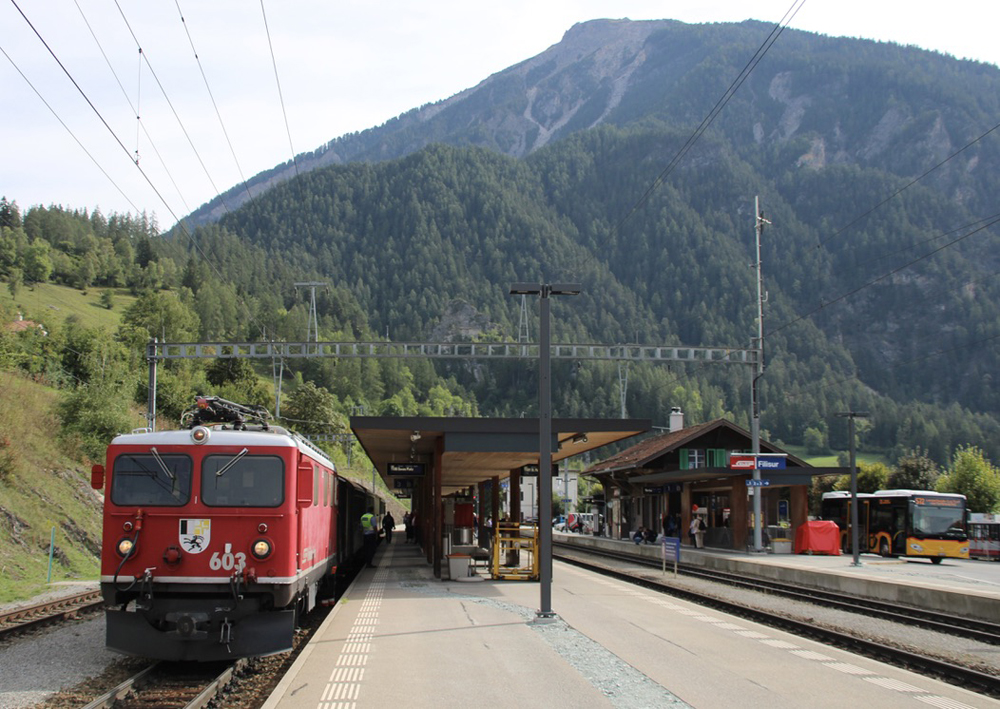
Swiss rail transportation being what it is, this train actually shows up in the national timetable as a regular regional train (only the fine print indicates it is a “nostalgiezug”), meaning anyone with a pass or a ticket between the two cities can climb aboard and ride as long as there is space. And the line is a nice one for such a trip, winding down a canyon route regularly punctuated with tunnels before dropping into Filisur to join the route to St. Moritz. The most memorable photo from this trip is probably the one that leads this report, from late on outbound run, when the Landwasser viaduct — arguably the single most famous railroading spot in Switzerland — suddenly appeared below us as a Glacier Express train crossed. The resulting image is a familiar view from an unfamiliar angle.
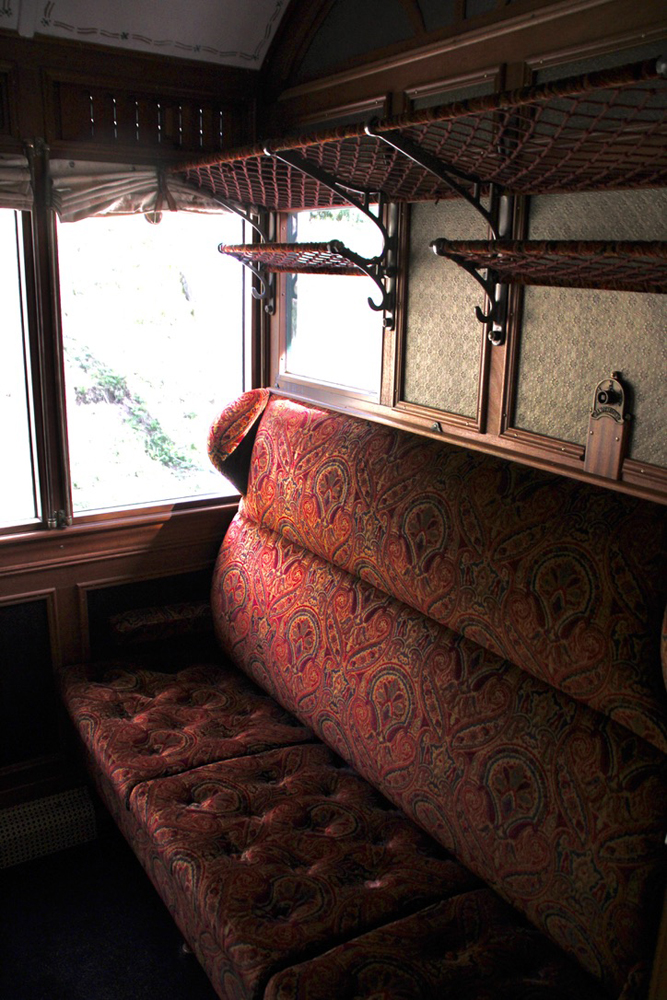
Having sat outside on the rather chilly Davos-Filisur trip, we moved into a wonderfully ornate (and somewhat more comfortable) 1920s first-class compartment for the return trip. From there, it was back to Chur.
Once back in Chur, it was time to catch another train to Arosa — and to ride it all the way to the end of the line this time. This spectacular little (16-mile-long) branch climbs from 584 meters (1,916 feet) to 1,739 meters (5,705 feet) with grades as steep as 6%. The line has a unique start, with more than a mile of street running through Chur (on a 3% grade) before making a dramatic transition from urban to mountain operation. I was told this is known as the RhB’s “safari line” because of the amount of wildlife riders will often see; I didn’t notice any, but this may well have been because I was focused on watching the trains navigating the endless series of curves, bridges and tunnels.
Beyond Langwies, where I had jumped off for my photo op the day before, I discovered trains navigate a series of horseshoe curves to climb out of Litzrüti, necessary to gain almost 900 feet in a little over three miles before reaching the end of the line in Arosa. Here’s a downbound train as seen from a Arosa-bound train, and one waiting at Litzrusi as photographed from a train heading back to Chur.
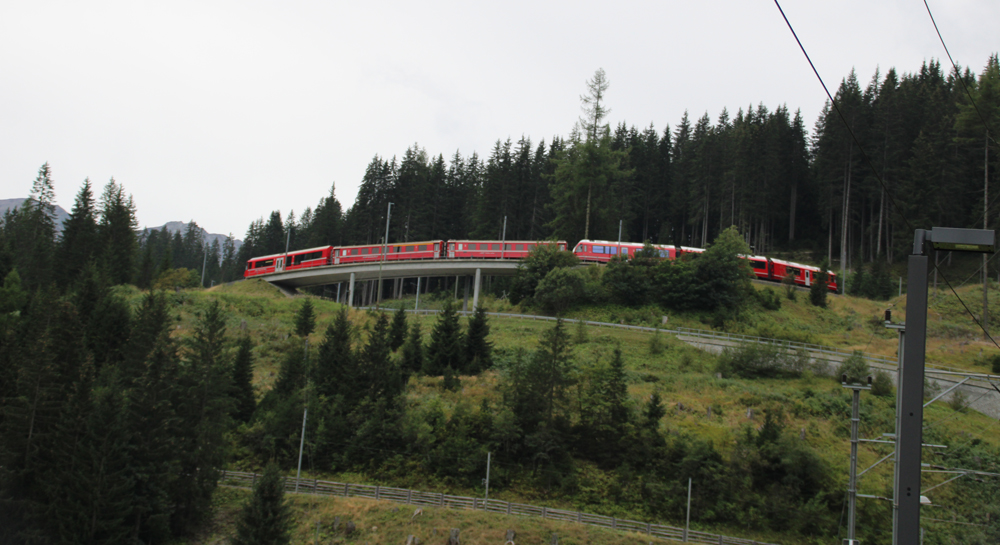
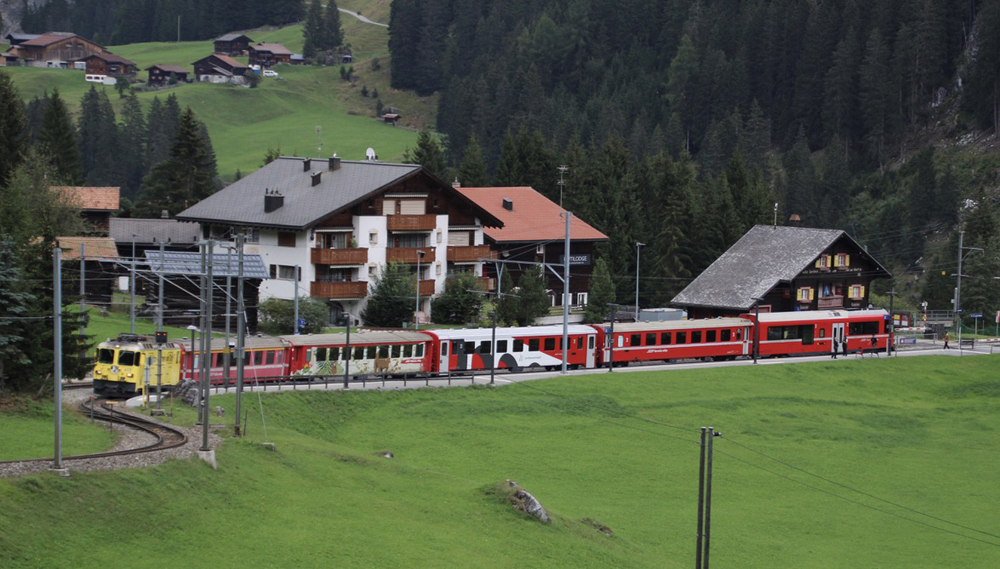
This is a line that the RhB would like to develop more from a tourism standpoint — and it certainly merits more visitor attention — but the fact that it’s a dead-end route is a bit of an impediment. Tourists who come to Arosa have no real choice but to go back to Chur, then move on to their next destination.
Thursday, Sept. 12: Another two-subject day with my RhB hosts. In the morning, Simona Sutter, the assistant to the head of the railway’s freight department, met me for a tour of the main freight facility in Landquart, where we discussed some of the specific challenges the company faces in growing its small freight business. I’m not going to go into it much here because this report is already getting too long, and because I suspect it will be a significant part of the eventual magazine article on the RhB. For now, I’ll just say that it’s interesting to see how tensions between freight and passenger operations can exist in exactly the reverse form that we know in North America.
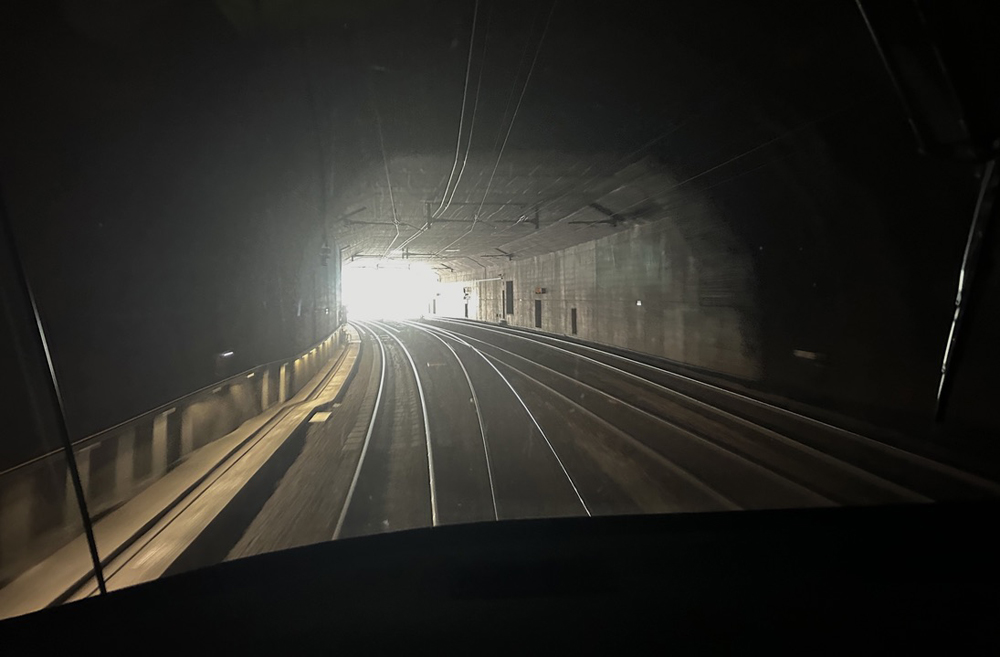
In the afternoon, I was rejoined by Markus Zaugg, the manager of rolling stock, for a trip to see the railroad’s car transporter operation through the 19.9-kilometer (12.36-mile) Vereina Tunnel between Klosters and Sagliains. Drivers of cars and trucks elect to pay to ride on the drive-on, drive-off train through the tunnel — an 18-minute trip, rather than drive over Flüela Pass that can take 45 minutes in god weather — and is not possible in winter, when snow closes the pass. Simon Rohner, head of the car transport operation, explained how the transporter works, and displayed the various monitors that ensure vehicles fit the car-carrier profile (and are not overheating, since a fire on the transport trains is the operation’s worst nightmare). I then made one round trip with a transporter train — in the cab in one direction, and in Rohner in his car in the other. This is not the only car-transporter operation in Switzerland, but it’s the only one that can handle large trucks. And it’s so successful that the RhB now hugely regrets that the tunnel was built with a single track, since that badly limits the capacity of the operation.
Friday, Sept. 13: Today’s theme was railroad vs. nature — somewhat appropriate on a rainy day when the RhB had concerns that early snows on its highest passes could cause operating problems. (At last check, no such problems had developed.)
Gilbert Zimmerman, the head of rail line maintenance for RhB’s north lines, took me first to the Carrerbach bridge, on a tributary of the Rhine near the Versam-Safien station. The current bridge at this site is the third, the first two having been washed out by sudden, dramatic flash floods. The newest one has also been hit by such floods, but has survived because of knowledge gained from the earlier washout. The third bridge is also distinguished by a high-tech warning system that gives the railroad time to halt trains in case of another dangerous flash flood, thanks to upstream monitoring, as well as a battery of cameras and sensors at the rail bridge itself. Any sudden rise in the water level will trigger red signals on either side of the bridge.
I knew the afternoon was going to be interesting when Zimmerman turned to me and said, “By the way, are you afraid of heights?”
A few minutes later, I found myself walking across a board on small gap in a bridge under construction that rose some 55 meters (about 180 feet) above a creek below. (Clearly, my answer was no. And it wasn’t as dangerous as it sounds; if I’d slipped, I would have fell a few feet, not 180. My camera, however, would have been singing Nearer My God To Three.)
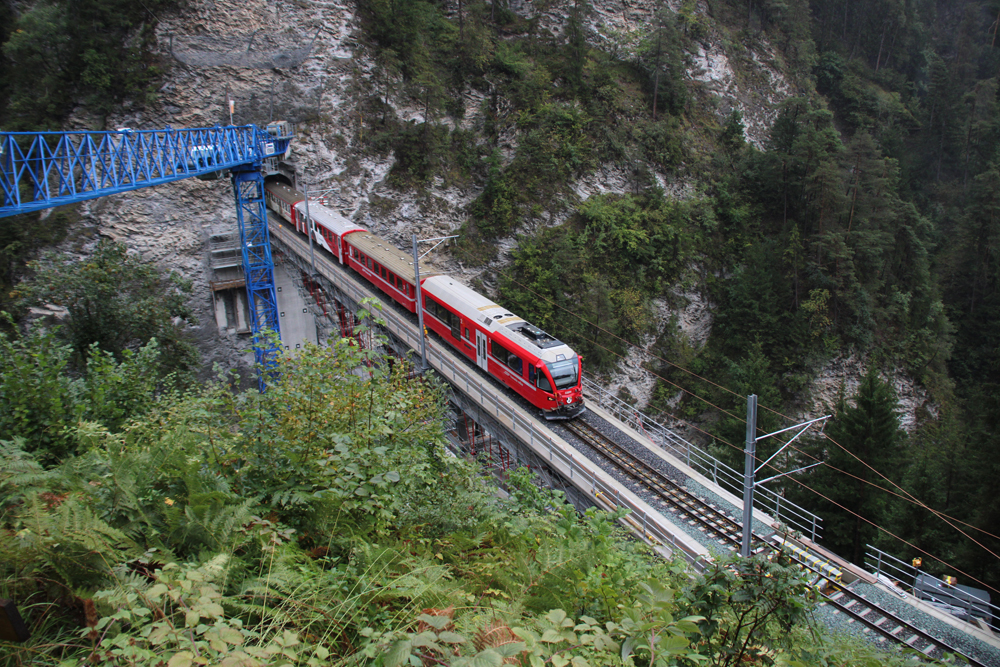
I was once again on the Arosa line, as we visited the Castieler Viaduct, a project to replace what was once a stone-arch bridge with a new, ingeniously designed steel bridge. At this site, the problem is the hillside is sliding, slowly, at one end of the bridge, while the other (where the bridge goes immediately into a tunnel) literally has rock-solid footing. The resulting forces had knocked the old bridge askew, cracking supporting bolts, among other problems. The solution — which is going to be hard to explain in a few words, but I’ll try — is that at the end of the bridge where the hill is sliding, the bridge is actually built with some short removable sections. Over time, as the hillside intrudes on the landing at that end, these pieces will be removed, allowing that end to move with the hillside on floating supports while the other end remains anchored in place. Zimmerman, whose background is in bridge engineering, was part of a four-person team who came up with this unique solution, which should allow the bridge to survive — despite the forces of nature — for at least 80 years.
It was amazing stuff. As, really was the entirety of my visit to the RhB. Officially, that’s now over. But I’ll spend the weekend riding portions of the railroad I have yet to visit, hopefully getting some additional photos, before moving on to my next feature subject. But more on that when the time comes.









